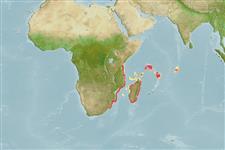Elasmobranchii (tubarões e raias) (sharks and rays) >
Carcharhiniformes (Ground sharks) >
Proscylliidae (Finback catsharks)
Etymology: Eridacnis: Etymology not explained, possibly eri-, Greek intensive particle (i.e., very), and dakno (Gr.), bite, referring to “wide, angular” mouth of E. radcliffei. (See ETYFish); sinuans: Latin for sinuous, probably referring to its slender body and/or long, ribbon-like caudal fin. (See ETYFish).
More on author: Smith.
Environment: milieu / climate zone / depth range / distribution range
Ecologia
marinhas batidemersal; intervalo de profundidade 180 - 480 m (Ref. 244). Deep-water; 4°S - 30°S
Western Indian Ocean: confined to South Africa, Mozambique and Tanzania.
Length at first maturity / Tamanho / Peso / Idade
Maturity: Lm ?, range 37 - ? cm
Max length : 37.0 cm TL (female)
Descrição breve
Morfologia | Morfometria
Espinhos dorsais (total): 0; Raios dorsais moles (total): 0; Espinhos anais 0; Raios anais moles: 0. A slender, dwarf catshark with 2 equal-sized dorsal fins and a long tape-like caudal fin (Ref. 5578). Grey-brown in color (Ref. 5578).
Found on the upper continental slope and outer shelf (Ref. 244). Feeds on small bony fishes, crustaceans and cephalopods (Ref. 244). Ovoviviparous (Ref. 50449), with 2 young in a litter (Ref. 244). Geographic or bathymetric segregation of populations by sex probably occurs as most specimens taken off Natal were male (Ref. 244).
Ovoviviparous, embryos feed solely on yolk (Ref. 50449). Bears two young (Ref. 5578). Size at birth between 15 and 17 cm (Ref. 244).
Compagno, L.J.V., 1984. FAO Species Catalogue. Vol. 4. Sharks of the world. An annotated and illustrated catalogue of shark species known to date. Part 2 - Carcharhiniformes. FAO Fish. Synop. 125(4/2):251-655. Rome: FAO. (Ref. 244)
Categoria na Lista Vermelha da IUCN (Ref. 130435)
Utilização humana
Warning: mysqli::__construct(): (HY000/1040): Too many connections in /var/www/html/includes/func_getlabel.php on line 46
Can't connect to MySQL database (fbapp). Errorcode: Too many connections
